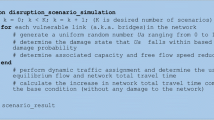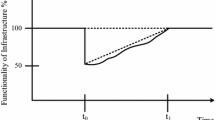Abstract
Transportation networks and systems are vulnerable to natural disasters. During disaster response operations, the degraded functionality of the system can negatively impact the affected population because disrupting relief activitiesincreases human suffering resulting from the lack of access to essential goods or services. Mathematical formulations for assessing transportation network vulnerability do not generally consider this lack of access or deprivation costs, and can lead to inappropriate strategies for humanitarian assistance. This paper proposes a transportation network vulnerability assessment model that allows identifying critical links for the development of high impact disaster response operations. The model is based on an economic analysis that considers the logistical costs of the distribution operations and the external effects derived from the delays in the provision of basic supplies (deprivation costs). The approach is particularly useful for planning resilient disaster response plans in the preparednessstage, prioritizing investment for mitigation and adaptation, and prioritizing the rehabilitation (access restoration) of the disrupted links in the response and recovery stages. In addition to numerical experiments using case study networks, the authors implemented the model to the coffee-producing region of Colombia, which was hit by an earthquake in 1999.













Similar content being viewed by others
References
Agarwal J, Liu M, Blockley D (2011) A systems approach to vulnerability assessment. Paper presented at the vulnerability, uncertainty, and risk: analysis, modeling, and management - Proceedings of the ICVRAM 2011 and ISUMA 2011 conferences, 230–237. https://doi.org/10.1061/41170(400)28
Agarwal J, Liu M, Galvan G (2014) Vulnerability and resilience of networked infrastructures. Paper presented at the vulnerability, uncertainty, and risk: quantification, mitigation, and management - Proceedings of the 2nd international conference on vulnerability and risk analysis and management, ICVRAM 2014 and the 6th international symposium on uncertainty modeling and analysis, ISUMA 2014, 2811–2820. https://doi.org/10.1061/9780784413609.283
Balijepalli C, Oppong O (2014) Measuring vulnerability of road network considering the extent of serviceability of critical road links in urban areas. J Transp Geogr 39:145–155. https://doi.org/10.1016/j.jtrangeo.2014.06.025
Berdica K (2002) An introduction to road vulnerability: what has been done, is done and should be done. Transp Policy 9(2):117–127. https://doi.org/10.1016/S0967-070X(02)00011-2
Berdica K, Eliasson J (2004) Regional accessibility analysis from a vulnerability perspective. The second international symposium on transportation network reliability, INSTR
Bíl M, Vodák R (2015) The stochastic approach in road network vulnerability analysis. Safety and reliability: methodology and applications. Taylor & Francis Group, London, pp 929–932
Bono F, Gutiérrez E (2011) A network-based analysis of the impact of structural damage on urban accessibility following a disaster: the case of the seismically damaged Port Au Prince and Carrefour urban road networks. J Transp Geogr 19(6):1443–1455. https://doi.org/10.1016/j.jtrangeo.2011.08.002
Brey R (2009) Valoración económica de externalidades asociadas a proyectos de transporte: fundamentos y procedimientos. Documento de trabajo. Ministerio de Fomento. Disponible en: http://www.evaluaciondeproyectos.es/EsWeb/Resultados/DocTrab/PDF/Actividad4/Es4–2.pdf
Cantillo V, Jaller M, Holguín-Veras J (2014) The Colombian strategic freight transport model based on product analysis. PROMET Traffic Transp 26(6):487–496
Cantillo V, Serrano I, Macea LF, Holguín-Veras J (2017) Discrete choice approach for assessing deprivation cost in humanitarian relief operations. Socio Econ Plan Sci. https://doi.org/10.1016/j.seps.2017.06.004
Cardona OD (2001) La necesidad de repensar de manera holística los conceptos de vulnerabilidad y riesgo. Una crítica y una revisión necesaria para la gestión. International work-conference on vulnerability in disaster theory and practice
Caschili S, Reggiani A, Medda F (2015) Resilience and vulnerability of spatial economic networks. Netwo Spat Econ 15(2):205–210. https://doi.org/10.1007/s11067-015-9283-9
Cavallo E, Noy I (2009) The economics of natural disasters: a survey. Inter-American development bank. Working paper No. 35. Available at https://ssrn.com/abstract=1817217. Accessed 15 June 2016
CEPAL P (1999) El terremoto de enero de 1999 en Colombia: impacto socioeconómico del desastre en la zona del Eje Cafetero. Comisión Económica para América Latina y el Caribe–CEPAL, Santiago
Chen A, Yang C, Kongsomsaksakul S, Lee M (2007) Network-based accessibility measures for vulnerability analysis of degradable transportation networks. Netwo Spat Econ 7(3):241–256. https://doi.org/10.1007/s11067-006-9012-5
Chen BY, Lam WHK, Sumalee A, Li Q, Li Z-C (2012) Vulnerability analysis for large-scale and congested road networks with demand uncertainty. Transp Res A Policy Pract 46(3):501–516. https://doi.org/10.1016/j.tra.2011.11.018
Cohen RE (2008) Lecciones aprendidas durante desastres naturales: 1970-2007. Rev Peru Med Exp Salud Publica 25(1):109–117
Darayi M, Barker K, Santos JR (2017) Component importance measures for multi-industry vulnerability of a freight transportation network. Netw Spat Econ 17(4):1111–1136. https://doi.org/10.1007/s11067-017-9359-9
De Jong G, Daly A, Pieters M, van der Hoorn T (2007) The logsum as an evaluation measure: review of the literature and new results. Transp Res A Policy Pract 41(9):874–889. https://doi.org/10.1016/j.tra.2006.10.002
Dehghani MS, Flintsch G, McNeil S (2014) Impact of road conditions and disruption uncertainties on network vulnerability. J Infrastruct Syst 20(3). https://doi.org/10.1061/(ASCE)IS.1943-555X.0000205
Di Gangi M, Luongo A (2005) Measures of network vulnerability indicators for risk evaluation and exposure reduction. Environ Health Risk III 9:1151
Dial RB (1971) A probabilistic multipath traffic assignment model which obviates path enumeration. Transp Res 5(2):83–111. https://doi.org/10.1016/0041-1647(71)90012-8
Domencich TA, McFadden D (1975) Urban travel demand-a behavioral analysis
Erath AL (2011) Vulnerability assessment of road transport infrastructure. ETH Zurich, Zurich
Freeman S, Taylor MA, Holyoak N, Australia S (2008) Vulnerability analysis of road networks. Doctoral dissertation. Institute for sustainable systems and technologies, University of South Australia. Available at http://www.cmnzl.co.nz/assets/sm/4444/61/paper76-Freeman.pdf. Accessed 8 July 2016
Gómez C, Buriticá J, Sánchez-Silva M, Dueñas-Osorio L (2011) Optimisation-based decision-making for complex networks in disastrous events. Int J Risk Assessment Manage 15(5–6):417–436
Gómez C, Sanchez-Silva M, Dueñas-Osorio L, Rosowsky D (2013) Hierarchical infrastructure network representation methods for risk-based decision-making. Struct Infrastruct Eng 9(3):260–274. https://doi.org/10.1080/15732479.2010.546415
Griffith DA, Chun Y (2015) Spatial autocorrelation in spatial interactions models: geographic scale and resolution implications for network resilience and vulnerability. Netwo Spat Econ 15(2):337–365. https://doi.org/10.1007/s11067-014-9256-4
Holguín-Veras J, Jaller M (2011) Immediate resource requirements after hurricane Katrina. Nat Hazard Rev 13(2):117–131
Holguín-Veras J, Jaller M, Van Wassenhove LN, Pérez N, Wachtendorf T (2012) On the unique features of post-disaster humanitarian logistics. J Oper Manag 30:494–506. https://doi.org/10.1016/j.jom.2012.08.003
Holguín-Veras J, Pérez N, Jaller M, Van Wassenhove LN, Aros-Vera F (2013) On the appropriate objective function for post-disaster humanitarian logistics models. J Oper Manag 31(5):262–280. https://doi.org/10.1016/j.jom.2013.06.002
Holguín-Veras J, Jaller M, Van Wassenhove LN, Pérez N, Wachtendorf T (2014) Material convergence: important and understudied disaster phenomenon. Nat Hazard Rev 15(1):1–12. https://doi.org/10.1061/(ASCE)NH.1527-6996.0000113
Holguín-Veras J, Amaya-Leal J, Cantillo V, Van Wassenhove LN, Aros-Vera F, Jaller M (2016) Econometric estimation of deprivation cost functions: a contingent valuation experiment. J Oper Manag 45:44–56. https://doi.org/10.1016/j.jom.2016.05.008
Holling CS (1973) Resilience and stability of ecological systems. Annu Rev Ecol Syst 4(1):1–23. https://doi.org/10.1146/annurev.es.04.110173.000245
Jaller M (2011) Resource allocation problems during disasters: the cases of points of distribution planning and material convergence handling. Ph.D., Rensselaer Polytechnic Institute
Jaller M, González-Calderón CA, Yushimito WF, Sánchez-Díaz ID (2015) An investigation of the effects of critical infrastructure on urban mobility in the city of Medellín. Int J Crit Infrastruct 11(3):213–232. https://doi.org/10.1504/IJCIS.2015.072158
Jenelius E (2009) Network structure and travel patterns: explaining the geographical disparities of road network vulnerability. J Transp Geogr 17(3):234–244. https://doi.org/10.1016/j.jtrangeo.2008.06.002
Jenelius E (2010) Redundancy importance: links as rerouting alternatives during road network disruptions. Procedia Eng 3:129–137. https://doi.org/10.1016/j.proeng.2010.07.013
Jenelius E, Mattsson L-G (2012) Road network vulnerability analysis of area-covering disruptions: a grid-based approach with case study. Transp Res A Policy Pract 46(5):746–760. https://doi.org/10.1016/j.tra.2012.02.003
Jenelius E, Petersen T, Mattsson L-G (2006) Importance and exposure in road network vulnerability analysis. Transp Res A Policy Pract 40(7):537–560. https://doi.org/10.1016/j.tra.2005.11.003
Kellogg JN, Vega V, Stailings T, Aiken CL (1995) Tectonic development of Panama, Costa Rica, and the Colombian Andes: constraints from global positioning system geodetic studies and gravity. Geol Soc Am Spec Pap 295:75–90
Lee S, Kim J, Lee S, Chang-Richards Y (2014) Development of resilience index in transport systems. 10th international conference of the international institute for infrastructure resilience and reconstruction (I3R2), Purdue University, West Lafayette, https://doi.org/10.5703/1288284315356
Lu Q-C, Peng Z-R, Zhang J (2014) Identification and prioritization of critical transportation infrastructure: case study of coastal flooding. J Transp Eng 141(3):04014082. https://doi.org/10.1061/(ASCE)TE.1943-5436.0000743#sthash.QaAOZWX6.dpuf
Luathep P, Suwanno P, Taneerananon P (2013) Identification of critical locations in road networks due to disasters. Proceedings of the Eastern Asia society for transportation studies
Márquez L, Cantillo V (2013) Evaluating strategic freight transport corridors including external costs. Transp Plan Technol 36(6):529–546. https://doi.org/10.1080/03081060.2013.830892
Matisziw TC, Murray AT, Grubesic TH (2010) Strategic network restoration. Netwo Spat Econ 10(3):345–361. https://doi.org/10.1007/s11067-009-9123-x
McFadden D (1973) Conditional logit analysis of qualitative choice behavior. In: Zarembka P (ed) Frontiers in econometrics. Academic Press, New York, pp 105–142
Modica M, Reggiani A (2015) Spatial economic resilience: overview and perspectives. Netwo Spat Econ 15(2):211–233. https://doi.org/10.1007/s11067-014-9261-7
Nagurney A, Qiang Q (2009) A relative total cost index for the evaluation of transportation network robustness in the presence of degradable links and alternative travel behavior. Int Trans Oper Res 16(1):49–67. https://doi.org/10.1111/j.1475-3995.2009.00659.x
OPS O. P. d. l. S (2000) Los desastres naturales y la protección de la salud. Pan American Health Org, Washington, DC
OPS O. P. d. l. S (2001) Logística y gestión de suministros humanitarios en el sector salud. Pan American Health Org, Washington, D.C
Ortuzar JDD, Willumsen LG (2011) Modelling transport. Wiley, New Jersey
Páez A, Scott DM, Morency C (2012) Measuring accessibility: positive and normative implementations of various accessibility indicators. J Transp Geogr 25:141–153. https://doi.org/10.1016/j.jtrangeo.2012.03.016
Pérez N, Holguín-Veras J (2015) Inventory-allocation distribution models for postdisaster humanitarian logistics with explicit consideration of deprivation costs. Transp Sci 50(4):1261–1285. https://doi.org/10.1287/trsc.2014.0565
Qiang Q, Nagurney A (2008) A unified network performance measure with importance identification and the ranking of network components. Optim Lett 2(1):127–142. https://doi.org/10.1007/s11590-007-0049-2
Qiang P, Nagurney A (2012) A bi-criteria indicator to assess supply chain network performance for critical needs under capacity and demand disruptions. Transp Res A Policy Pract 46(5):801–812. https://doi.org/10.1016/j.tra.2012.02.006
Rodríguez-Núñez E (2012) Estudio de la vulnerabilidad de redes de transporte desde una perspectiva geográfica. Revista de Estudios Andaluces 29(1):59–82. https://doi.org/10.12795/rea.2012.i29.03
Rodríguez-Núñez E, García-Palomares JC (2014) Measuring the vulnerability of public transport networks. J Transp Geogr 35:50–63. https://doi.org/10.1016/j.jtrangeo.2014.01.008
Rupi F, Angelini S, Bernardi S, Danesi A, Rossi G (2015a) Ranking links in a road transport network: a practical method for the calculation of link importance. Transp Res Procedia 5:221–232. https://doi.org/10.1016/j.trpro.2015.01.003
Rupi F, Bernardi S, Rossi G, Danesi A (2015b) The evaluation of road network vulnerability in mountainous areas: a case study. Netwo Spat Econ 15(2):397–411. https://doi.org/10.1007/s11067-014-9260-8
Schreiner S (2013) Urban transport and logistics in cases of natural disasters. In: Taniguchi E, Fwa TF, Thompson RG (eds) Urban transportation and logistics: health, safety, and security concerns. CRC Press, Boca Raton, pp 225–244
Scott DM, Novak DC, Aultman-Hall L, Guo F (2006) Network robustness index: a new method for identifying critical links and evaluating the performance of transportation networks. J Transp Geogr 14(3):215–227. https://doi.org/10.1016/j.jtrangeo.2005.10.003
Sohn J (2006) Evaluating the significance of highway network links under the flood damage: an accessibility approach. Transp Res A Policy Pract 40(6):491–506. https://doi.org/10.1016/j.tra.2005.08.006
Stauffer JM, Pedraza-Martinez AJ, Van Wassenhove LN (2016) Temporary hubs for the global vehicle supply chain in humanitarian operations. Prod Oper Manag 25(2):192–209. https://doi.org/10.1111/poms.12427
Sullivan JL, Novak DC, Aultman-Hall L, Scott DM (2010) Identifying critical road segments and measuring system-wide robustness in transportation networks with isolating links: a link-based capacity-reduction approach. Transp Res A Policy Pract 44(5):323–336. https://doi.org/10.1016/j.tra.2010.02.003
Taylor MAP (2008) Critical transport infrastructure in urban areas: impacts of traffic incidents assessed using accessibility-based network vulnerability analysis. Growth Chang 39(4):593–616. https://doi.org/10.1111/j.1468-2257.2008.00448.x
Taylor MA, D’Este G (2005) An accessibility based method for vulnerability analysis in strategic transport networks. NSW Transport and Population Data Centre
Taylor MAP, Susilawati (2012) Remoteness and accessibility in the vulnerability analysis of regional road networks. Transp Res A Policy Pract 46(5):761–771. https://doi.org/10.1016/j.tra.2012.02.008
Taylor MAP, Sekhar SVC, D'Este GM (2006) Application of accessibility based methods for vulnerability analysis of strategic road networks. Netwo Spat Econ 6(3):267–291. https://doi.org/10.1007/s11067-006-9284-9
Train KE (2009) Discrete choice methods with simulation. Cambridge university press, Cambridge
United Nations (2014) Human development report 2014: sustaining human progress-reducing vulnerabilities and building resilience (PDF), UN
Wang DZW, Liu H, Szeto WY, Chow AHF (2016) Identification of critical combination of vulnerable links in transportation networks – a global optimisation approach. Transportmetrica A Transp Sci 12(4):346–365. https://doi.org/10.1080/23249935.2015.1137373
Williams HC (1977) On the formation of travel demand models and economic evaluation measures of user benefit. Environ Plan A 9(3):285–344
Yu S, Kim S-W, Oh C-W, An H, Kim J-M (2015) Quantitative assessment of disaster resilience: an empirical study on the importance of post-disaster recovery costs. Reliab Eng Syst Saf 137:6–17. https://doi.org/10.1016/j.ress.2014.12.007
Yushimito W, Jaller M, Ukkusuri S (2012) A voronoi-based heuristic algorithm for locating distribution centers in disasters. J Netw Spat Econ 12(1):21–39. https://doi.org/10.1007/s11067-010-9140-9
Zhong Z, Huang Z, Du X (2010) Identifying critical locations of post-earthquake transportation networks based on vulnerability analysis. Paper presented at the ICLEM 2010: logistics for sustained economic development - Infrastructure, information, integration - Proceedings of the 2010 international conference of logistics engineering and management 387:2931–2937. https://doi.org/10.1061/41139(387)410
Acknowledgements
This research was partially funded by the Partnerships for Enhanced Engagement in Research (PEER) Science’s project “Integrated Humanitarian Logistics System for Developing Countries” (PGA-2000003441), by the Volvo Research and Educational Foundations (SVG-2015-02) and Colciencias (Cod 1215-675-47211).
Author information
Authors and Affiliations
Corresponding author
Appendix 1. Pseudocode Model
Appendix 1. Pseudocode Model


Rights and permissions
About this article
Cite this article
Cantillo, V., Macea, L.F. & Jaller, M. Assessing Vulnerability of Transportation Networks for Disaster Response Operations. Netw Spat Econ 19, 243–273 (2019). https://doi.org/10.1007/s11067-017-9382-x
Published:
Issue Date:
DOI: https://doi.org/10.1007/s11067-017-9382-x




